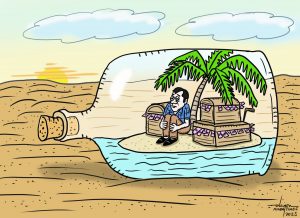A GROUP of environmentalists has recently filed a petition with the Supreme Court (SC) seeking the issuance of a Writ of Kalikasan. The group wants to stop the ongoing construction of the Davao City-Samal Island Connector Bridge.
No, the environmentalist group is not against the bridge project. Rather, its members are against the bridge alignment. The advocates for environment protection and preservation claim the alignment passes through an undersea protected area, thus endangering the marine habitat as well as the mangrove trees that have been taken care of by certain families for many, many years already.
Of course, we deeply appreciate the initiative of the group to go as high as the land’s highest court if only to ensure that the underwater denizens, as well as the mangroves, will continue to thrive. But was their petition for the issuance of a Writ of Kalikasan a rather too-late act of supposedly environmental heroes?
The construction of the almost four-kilometer bridge, including its approaches in Davao City and the Island Garden City of Samal has been underway since some three years ago. In other words, the national government has already sunk a substantial amount from the budget of the project.
In fact, the contractor has accomplished roughly thirty percent of the work. Meaning, should the High Court issue the Writ of Kalikasan just to agree to the environmentalists’ demand, it would be allowing the wastage of billions worth of people’s money.
Moreover, there is no denying the fact that the bridge construction is one project that is expected to bring to the highest level the economic development of the island city. In the same manner, it will also contribute to the progress of the Davao mainland. In other words, the beneficiaries of the bridge project will be much more than those who are likely sufferers.
Clearly, the environmentalists will agree with us that addressing the problem of underwater degradation is far less expensive than abandoning or transferring the bridge project to a new location or realigning it.
In other words, our take on the matter is that the petitioners would rather find means with which to rehabilitate any affected underwater habitat or make artificial marine life sanctuaries within the vicinity of the affected areas.
After all, there seems nothing impossible to create using modern technology. We have no doubt that environmental advocates are not short of people with the best brains. They can develop schemes to rehabilitate the damaged underwater habitat or create new sites.
All they have to do is put their ideas in writing, develop them into a project proposal, etc., and submit them to appropriate government agencies or even supportive private organizations.
In such a manner, no feelings get hurt, and the project can proceed without further delay. It’s been years since the idea of a Samal-Davao City bridge was laid on the table. To stop it now that the project is well on its way to realization is adding debilitation to the long-awaited progress of the Island Garden City of Samal and Davao City as well.
**********************************
Last Monday, only a day after Easter, the entire Christian world was shocked by the “not-too-soon-expected” death of Pope Francis.
Yes, the first-ever Latin American Pope to serve as the head of the more than 1.3 billion Catholics in the entire world lost in his battle for life. He was hospitalized for a month and was released only recently. While he was expected to recuperate it was clear in his appearance in the morning of Easter at the Basilica Square that he was not well. In fact, as can be seen on television, he hardly lifted his hand to wave to the crowd who witnessed his appearance.
And last Monday morning his death was officially announced to the world. Leaders of nations with varying religious beliefs sent their condolences. Even top officials of Muslim countries who admitted their people were touched by the ways of the so-called pro-poor Pontiff, did not hesitate to share their appreciation of Pope Francis.
With his death, the College of Cardinals, with three Filipino Church leaders participating, will be choosing Pope Francis’ replacement. And they have to vote for their choice within 20 days the longest since the death of the Pontiff.
One of those touted to be in the elite circle of “favorites” is Filipino Cardinal Juan Tagle. Will he make it? If he will, God willing, then he will be the first Asian prelate to become Pope.
But then, again, even in choosing the Church’s top leader, there is politics – the reason why some controversies were discovered at the Vatican.
Anyhow, there are seventeen more days to wait. By then the Christian world will know who will be the next Pope.

